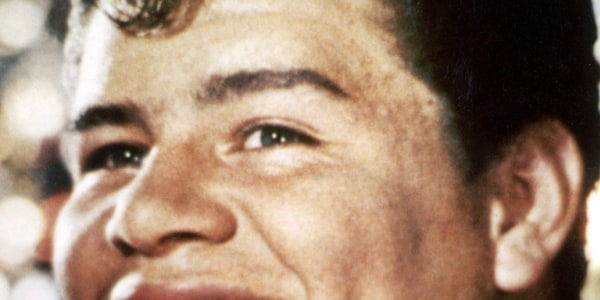In his new book “The Great Progression: How Hispanics Will Lead America to a New Era of Prosperity,”award-winning journalist Geraldo Rivera details the evolving role of Hispanics in shapingevery facet of American culture. Read an excerpt on how the Hispanic community has socially, economically and politically impacted our future.
Introduction
For the first time in modern world history a powerful nation is changing complexion right before the eyes of its citizens. In real time it is possible to watch America become more culturally diverse, its face physically darker. The United States has vastly more Latinos than it did just a relatively few years ago, and their numbers are increasing at an explosive rate, on average almost four thousand per day.
This book is about what that dramatic trend means for the country.
Aided by the vast oceans that separate the United States from the planet’s densest population centers, and by America’s early instincts toward isolation, for most of the twentieth century our nation managed to exclude most Asians, Africans, and Latinos. With passionate vigilance and a largely race-based immigration policy, the country remained overwhelmingly white and Anglo for the first two and a half centuries of its existence.
The relaxation of that restrictive policy in the 1960s civil rights era resulted in a tsunami of Latino migration, which, when coupled with an explosive domestic birth rate, inflated the U.S. Hispanic population to a size almost ten times bigger than it was just fifty years ago, in both absolute and relative terms. In 1950, there were 5 million Latinos. Today, there are more than 46 million. And the recent downturn in illegal immigration due to the lack of good construction jobs in our faltering economy will only marginally slow the pace. During that half-century, Asian and African-American populations also increased, but by not nearly as impressive a rate as that of Hispanics.
A library of scary books and an almost infinite galaxy of anti-immigration opinion pieces warn of how the inexorably increasing numbers of Latinos in the United States are or will soon be overwhelming the existing social order and making America a fundamentally different nation from the one contemplated by the fifty-six signatories of the Declaration of Independence, who were all white Anglos (and only one of whom, Charles Carroll of Maryland, was even Catholic, a then still exotic religion in the thirteen original colonies).
By fundamentally different, I mean a nation other than the industrious, God-fearing, ethical, family-valued, disciplined, self-governing and moral New World colossus the Founding Fathers contemplated. Those fears are widespread, and whether you think them justified or overblown, it is undeniable that the phenomenal Latino population surge in the United States since those revolutionary days is stunning and irreversible.
The percentage of Latinos in the United States population stands at 15.4 percent, which in April 2009 amounted to about 46.7 million people, if not yet strong, getting stronger politically, culturally and economically. Despite the dramatic decrease, even reversal, in recent immigration caused by the collapsing U.S. economy, by the time you read this that 46.7 million figure will already be an understatement of a rapidly expanding demographic, which grew more than 3 percent in the single year between July 2006 and July 2007, and more than doubled just since 1990. Hispanics for the first time outnumber non-Hispanic whites in Dallas, Texas. They are 37 percent of the population of Houston and over 28 percent of the population of Chicago, Illinois.
Slideshow 14 photos
Latin Stars
Similarly, when the Census Bureau announced in March 2009 that New York City had reached a record 8,363,710 people, the bureau revealed that 28 percent were Hispanic, 2,341,839, up 27,000 between July 2007 and July 2008, and most of them native-born. The Latino populations of New York City (2.3 million) and Los Angeles (1.86 million) both outnumber the entire population of Barcelona, Spain, which has just 1.6 million residents. As Marcelo Suárez-Orozco, a professor of globalization and education at New York University, said when the population of the United States hit the breathtaking 300 million mark on October 17, 2006, that 300 millionth American was probably born in Los Angeles and was probably the daughter of Mexicans. “Probably, her name is Maria .... She is the future of America. She is a child of an immigrant. She is a U.S. citizen like you and me.”
In political terms, what makes that historic 15.4 percent statistic even more impressive is that it is comprised mostly of native-born Hispanics, citizens born in the U.S.A., not immigrants either legal or illegal. That is the most potentially profound political development since the silent majority.
As Rosario Dawson reminded us during the Inaugural Gala, as an ethnic group, Latinos are already second in size behind only non-Hispanic American whites. And the percentage of Hispanics is growing by twice their rate and almost that much faster than American blacks whom they supplanted as the nation’s largest minority, far ahead of the date predicted by the social scientists of the 1960s.
The states of Arizona, California, Colorado, Florida, Georgia, Illinois, Massachusetts, Nevada, New Jersey, New Mexico, New York, North Carolina, Pennsylvania, Texas, Virginia and Washington all have at least a half million Hispanic residents.
If current trends hold, 25 percent of the U.S. population will be Hispanic by 2040, and by the end of the twenty-first century, the United States will be a majority-Hispanic country. Put another way, there are people alive today who will be around to watch America take its place as the world’s largest Hispanic country by population. Perhaps more surprisingly, it is already number two behind just Mexico and already ahead of Spain. There was a March 2009 article reprinted in the Latino Business Review that referred to America’s burgeoning Latino population as Nuevo Hispania.“With more than 46 million people, Nuevo Hispania is the 27th-largest nation on Earth, and the fourth largest in the Western Hemisphere,” the article by NBC reporters Timothy Sun and Alex Johnson said. “Even as the rest of the economy contracts in global recession, Nuevo Hispania remains a thriving, even booming, market that’s expected to grow by 48 percent in the next four years.”
I wouldn’t encourage that “Nuevo Hispania” bit. It sounds way too nationalistic. There are already too many hard-core conservative critics who allege that our hidden goal is to separate the Spanish-dominant areas of the nation from the rest of the country. I would rather emphasize our inclusion as part of the American whole.
Lest you think the prospect of a majority-Hispanic America off-putting, the good news is that Latinos, by the most important measures, are pretty much the same as “traditional” Americans. As I said my first book on this topic, HisPanic — which, let me helpfully point out, is now available in paperback — most of us speak English, (almost certainly after the first generation). We love our children, our wives, families and friends, our country, our teams, pets, our prides and our prejudices. We certainly have our bad manzanas (apples), but in broad strokes, most work hard, go to church, serve in the military (a hundred thousand strong), and now vote, just like most Americans, maybe soon more than most. Almost three in four Latinos surveyed following the 2008 presidential election said they were more interested this time than in the 2004 election, and that their new found interest in the political scene would continue. The sleeping giant is awake.
Slideshow 20 photos
The life of Sonia Sotomayor
And from the point of view of the nation, that is a good thing, because the widely held work ethic among Latinos and the driving ambition so many hold to move their families up the social and economic food chain will help propel America to further greatness and prosperity. Latinos are the secret weapon of the country’s economy.
Granted, it might seem counter-intuitive that Latinos, of all people, should be identified as the current force to help right America’s economic ship of state. For many generations tracking back to the Middle Ages, Hispanics have been identified as virtually synonymous with grifters, gigolos, romancers, rapists, strike breakers, duelists, thieves or, in the New World worst of all, immigrants, especially illegal immigrants, takers from American society, not player-participants.
It is a bad rap made possible partially by the stereotype born of shared antagonistic history. In literature and movies our cultural ancestor Spain’s Catholic King Philip II is always portrayed as greasy, dark, tricky and wackily religious. And to many Anglo-Americans, U.S. Hispanics inherited and imported those traits into the United States. Since at least the 1588 defeat of Phillip II’s Spanish Armada by the navy of Elizabeth, Queen of England, and exacerbated by competition between the Spanish and English empires for world dominion, Hispanics have had a swarthy, amoral aspect attributed by the prevailing culture to our national/ethnic/racial roots, something vaguely sinister, voluptuous and lazy. Think belly-scratching siestas or Captain Hook, mustache-twirling predator.
Like Japanese-Americans during World War II, we have been the victims of a smear job of historic proportions. The deeply negative effect of the reckless anti-Hispanic immigrant propaganda campaign, especially during the early stages of the 2007-2008 presidential election cycle, can not be overstated from the point of view of most Hispanics in America, regardless of their party affiliation, economic heritage or racial self-image. There is almost no one — rich, poor, black, white, brown, peasant, jíbaro, caballero or caudillo — who is not still more or less offended by the harsh tone of the debate over Hispanic immigration.
The hard-right social conservatives shrieked about the Mexican swarm and made profoundly negative icons of young Latinos climbing the wall near Juárez or wading across the Rio Grande near Laredo, rafting ashore in south Florida, hiking across the Arizona desert at Nogales or beating the U.S. Customs and Immigration line at Tijuana. Meantime, real-world Hispanic American citizen voters looked around and realized how insulting the conversation had become.
In November 2008, Latinos made the Republican Party pay, and the price was steep: control of Congress and the White House. In record numbers Hispanics voted and in the end made a major, if not the decisive difference in the elections. By several sober analyses, including my own, there but for almost 12 million Hispanic voters John McCain would be president. But “I told you so” is not what this is about. The surge of Latino voters happened and, in a larger societal sense, is happening, and this book is about what that means.
My late, great ex-father-in-law Kurt Vonnegut once told me that when you talk to people, their primary concern is what your topic has to do with them. He also told me they were interested in how they could get your job, but that’s another story. Let me hasten to say that every conscientious American should root for the success of U.S. Hispanics, because they will be doing a hefty portion of our stressed nation’s economic heavy lifting going forward.
Like every group of immigrant newcomers that has come before, Latinos are filling vital and expanding roles in the U.S. economy. There is an entire class of strivers whose shops and bodegas do the commerce of the barrio, and that entrepreneurial spirit is matched by an intense and widespread work ethic among the legions who occupy the nation’s lower tiers of employment. “Latinos enter the labor force relatively early and do so robustly; Hispanic men in particular have the highest labor force participation rate of any subgroup (80.5%),” says the NCLR, quoting the U.S. Labor Department. That means more Latinos work, percentage-wise, than any other ethnic group.
I’ve been saying for most of my public life that in much of the United States there is scarcely a lawn mowed, a fruit picked or a baby cared for, but by a Hispanic. Citizen or not, millions toil in jobs that mainstream white and black cultures have moved away from, like fruit picking, poultry processing and meatpacking. “Those are Mexican jobs,” is an increasingly popular refrain in urban America. While many consider those dirty jobs as Gunga Din-class labor and see them as demeaning drudgery, Latinos, particularly the newer arrivals, have seized the opportunities that exist at or near the bottom of our still relatively affluent society, so down-low it is only minimally affected even in these times of widespread economic travail, turmoil and stress. You can still find plenty of jobs cleaning toilets, scrubbing pots, plucking chickens and cutting off cow heads in August in Iowa.
None of the furloughed Big Three autoworkers nor the financial wizards exiled by Citigroup or Merrill nor most of the newly unemployed white-collar middle-class are going to take those grinding, chain gang-like jobs picking blueberries in Michigan, avocados in California, doing minimum-wage, cold-weather, semiskilled construction jobs in Jersey (good luck if they can even find them) or sewing cheap shirts in South Florida. Put a different way, if mainstream workers feel the need to compete for those jobs at the very bottom, the nation really is up the creek without a paddle.
And those young, hardworking Hispanic hard go-getters play a role beyond today. Because we have been inundated by unending, seldom varying cable news and talk radio reports and commentaries concerning the strain and drain Hispanics put on the economy, it is another perhaps counterintuitive fact that these largely entry-level workers are the secret weapon in the battle to keep the U.S. elderly solvent.
Slideshow 50 photos
Jennifer Lopez's rise to fame
As American society gets older, economists are united in their fear that the Social Security trust fund will be bankrupted by the explosive number of boomer retirees in proportion to the dwindling number, relatively speaking, of their children, those still producing and contributing to the system. But the grim prognosis does not adequately figure in the exceptional Latino population explosion that is filling the depleted ranks of the U.S. working class.
The median age of the white U.S. population is well over forty years old. For Hispanic Americans it is 27.6. In other words, the U.S. Hispanic population is on average more than twelve years younger than whites. You do the math when it comes to who will be working and paying into the Social Security trust fund.
Now, the nation, with President Obama at the wheel, is driving through a tough patch, maybe one of the toughest ever. Among Latinos, aside from worrying about their economic future, there is also concern that the tremendous gains made in integrating into larger American society will be eroded, that anti-immigrant sentiment is being further stoked by financial uncertainty; that an already difficult situation is being aggravated by hard times. This book attempts to explain why it is in America’s best interests to cheer on and encourage the legitimate aspirations of the group destined unalterably to play a gigantic role in our nation’s future. Like the Irish, Asian, African, German, Italian, Greek, Northern and Eastern Europeans, we are proud, eager, able travelers on our country’s Great Progression.
Excerpted from "The Great Progression: How Hispanics Will Lead America to a New Era of Prosperity,"by Geraldo Rivera. Copyright (c) 2009, reprinted with permission from Penguin Group.


